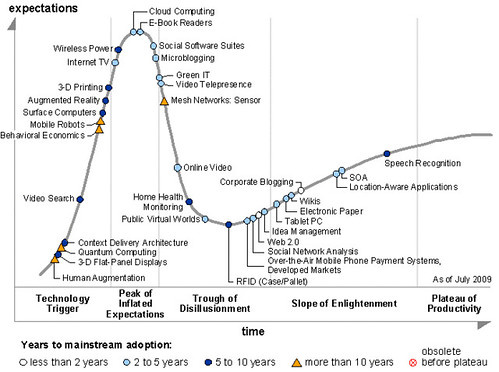Despite our strong desire to resist it, one of the great, unwavering facts of life is that things change. We, ourselves, go through cycles – or phases – where our interests, preferences, passions and even tastes change. You will have noticed these changes in yourself. Just consider the things you thought were important as a teenager – look particularly at the music that you were so passionate about. How many of those songs do you still love? How many would you still play for your new, more mature friends?
The same happens in business.
Ideas, technologies – and yes, even people – come into and fall out of favour. They often burst into our consciousness with great fanfare, gather hype and momentum and then drop lot a hot potato. The most tenacious ideas, technologies (and yes again, people) face up to this loss of prestige, gaining a new level of maturity and capability, eventually reaching a point of optimisation. Great examples of this are sites like Google+ … where initial interest was huge. This was followed by a rebound as the inert weight of user habit rebounded, seeing people maintain their account, but return to Twitter and Facebook. And now, we see the gradual maturing and more understated growth of the product – with users now finding substantial, specific value in its use.

Analyst firm, Gartner Inc, have described this process as The Hype Cycle for over 15 years now. It identifies peak points in visibility over time for technologies:
- The technology trigger
- Peak of inflated expectations
- Trough of disillusionment
- Slope of enlightenment
- Plateau of productivity
I have always loved the Hype Cycle. It explains a great deal not just about technology, but about human behaviour – behaviour that we can clearly see in the real time streams of sites like Facebook and Twitter.
But the challenge for business – especially with social media – is that there is never a SINGLE hype cycle. They always come in successive waves – for we also need to remember different people engage with, and adopt, change at different times. (And as David Armano points out, we need to deal with multiple complexities when it comes to change management – perception, thoughts, behaviours and outcomes.)
What we need within our businesses are different types of champions at different times.
I have written before on the rise of the Business Designer – a person uniquely adapted to optimise your business processes. But in line with the Hype Cycle, the Business Designer is most effective later in the cycle – as you climb out of the Trough of Disillusionment. Most businesses are not in this space as yet. And many are still facing the ascendant forces of the Peak of Inflated Expectations. It is in the way up this peak (and the way down the other side) that you need an individual uniquely suited to “getting s#@t done. You need the Social Media Mechanic.
This is the person who can implement your strategy, find the right bits and pieces and bolt them together. This person will know what needs to be done to make the right things work – and sometimes even do the wrong things (let’s face it, we’re still making mistakes and learning from them, right?).
But without the Social Media Mechanic, you’re just going to be left with a whole heap of unconnected parts. So once you’ve got your continuous digital strategy underway, start seeking your Social Media Mechanic. You’ll never get out of the trough of disillusion without one!
